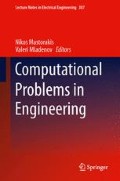Abstract
In this work, a modified Rosenzweig-MacArthur predator-prey model is analyzed, which is a particular Gause type model, considering two Allee effect affecting the prey population.
This phenomenon may be expressed by different mathematical expressions; with the form here used, the existence of one limit cycle surrounding a positive equilibrium point is proved.
Conditions to the existence of equilibrium points and their local stability are established; moreover, the existence of a separatrix curve dividing the behavior of trajectories which can have different ω-limit sets.
Some simulations reinforced our results are given and the ecological consequences are discussed.
Access this chapter
Tax calculation will be finalised at checkout
Purchases are for personal use only
References
Angulo E, Roemer GW, Berec L, Gascoigne J, Courchamp F (2007) Double Allee effects and extinction in the island fox. Conservation Biology 21: 1082–1091.
Barclay H, Mackauer M, (1980) The sterile insect release method for pest control: a density-dependent model. Environmental Entomology 9: 810–817.
Bazykin AD (1998) Nonlinear Dynamics of interacting populations, World Scientific Publishing Co. Pte. Ltd.
Berec L (2007) Models of Allee effects and their implications for population and community dynamics, In: Mondaini R (Ed.) Proceedings of the 2007 International Symposium on Mathematical and Computational Biology, E-papers Serviços Editoriais Ltda., pp. 179–207.
Berec L, Angulo E, Courchamp F (2007) Multiple Allee effects and population management, Trends in Ecology and Evolution 22: 185–191.
Boukal DS, Berec L (2002) Single-species models and the Allee effect: Extinction boundaries, sex ratios and mate encounters. Journal of Theoretical Biology 218: 375–394.
Boukal DS, Sabelis MW, Berec L (2007) How predator functional responses and Allee effects in prey affect the paradox of enrichment and population collapses. Theoretical Population Biology 72: 136–147.
Cheng KS (1981) Uniqueness of a limit cycle for a predator-prey system, SIAM Journal on Applied Mathematics 12: 541–548.
Chicone C (2006) Ordinary differential equations with applications (2nd edition). Texts in Applied Mathematics 34, Springer.
Clark CW (2010) Mathematical Bioeconomics: The Mathematics of Conservation (3nd ed). John Wiley and Sons Inc.
Coleman CS (1983) Hilbert’s 16th. Problem: How Many Cycles? In: Braun M, Coleman CS, Drew D (Eds). Differential Equations Model, Springer Verlag, pp. 279–297.
Conway ED, Smoller JA (1986) Global Analysis of a System of Predator-Prey Equations. SIAM Journal on Applied Mathematics 46: 630–642.
Courchamp F, Berec L, Gascoigne J (2008) Allee Effects in Ecology and Conservation, Oxford University Press.
Dumortier F, Llibre J, Artés JC (2006) Qualitative theory of planar differential systems, Springer.
Flores JD, Mena-Lorca J, González-Yañez B, González-Olivares E (2007) Consequences of Depensation in a Smith’s Bioeconomic Model for open-access Fishery. In: Mondaini R. (Ed.) Proceedings of the 2006 International Symposium on Mathematical and Computational Biology, E-papers Serviços Editoriais Ltda., pp. 219–232.
Freedman HI (1980) Deterministic Mathematical Model in Population Ecology, Marcel Dekker.
González-Olivares E, Ramos-Jiliberto R (2003) Dynamics consequences of prey refuges in a simple model system: more prey, fewer predators and enhanced stability. Ecological Modelling 106: 135–146.
González-Olivares E, González-Yañez B, Mena-Lorca J, Ramos-Jiliberto R (2007) Modelling the Allee effect: are the different mathematical forms proposed equivalents? In: Mondaini R (Ed.) Proceedings of the 2006 International Symposium on Mathematical and Computational Biology, E-papers Serviços Editoriais Ltda., Río de Janeiro, pp. 53–71.
González-Olivares E, Meneses-Alcay H, González-Yañez B, Mena-Lorca J, Rojas-Palma A, Ramos-Jiliberto R (2011) A Gause type predator-prey model with Allee effect on prey: Multiple stability and uniqueness of limit cycle. Nonlinear Analysis: Real World Applications 12: 2931–2942.
González-Olivares E, González-Yañez B, Mena-Lorca J, Rojas-Palma A, Flores JD (2011) Consequences of double Allee effect on the number of limit cycles in a predator-prey model. Computers and Mathematics with Applications 62: 3449–3463.
Hasík K (2010) On a predator-prey system of Gause type. Journal of Mathematical Biology 60: 59–74.
Kuang Y, Freedman HI (1988) Uniqueness of limit cycles in Gause-type models of predator-prey systems. Mathematical Biosciences 88: 67–84.
Liermann M, Hilborn R (2001) Depensation: evidence, models and implications. Fish and Fisheries 2: 33–58.
Meneses-Alcay H, González-Yañez E (2004) Consequences of the Allee effect on Rosenzweig-MacArthur predator-prey model. In: Mondaini R (ed.) Proceedings of the Third Brazilian Symposium on Mathematical and Computational Biology BIOMAT 2003, E-papers Serviços Editoriais Ltda., Volumen 2 pp. 264–277.
Stephens PA, Sutherland WJ (1999) Consequences of the Allee effect for behaviour, ecology and conservation. Trends in Ecology and Evolution 14: 401–405.
Stephens PA, Sutherland WJ, Freckleton RP (1999) What is the Allee effect?. Oikos 87: 185–190.
Turchin P (2003) Complex population dynamics. A theoretical/empirical synthesis, Monographs in Population Biology 35, Princeton University Press.
van Voorn GAK, Hemerik L, Boer MP, Kooi BW (2007) Heteroclinic orbits indicate overexploitation in predator-prey systems with a strong Allee effect. Mathematical Biosciences 209: 451–469.
Wang J, Shi J, Wei J (2011). Predator-prey system with strong Allee effect in prey. Journal of Mathematical Biology 62: 291–331.
Xiao D, Zhang Z (2003) On the uniqueness and nonexistence of limit cycles for predator-prey systems. Nonlinearity 16: 1185–1201.
Zu J, Mimura M (2010) The impact of Allee effect on a predator-prey system with Holling type II functional response. Applied Mathematics and Computation 217: 3542–3556.
Acknowledgement
The authors thank the members of the Grupo de Ecología Matemática on the Instituto de Matemáticas at the Pontificia Universidad Católica de Valparaíso, for their valuable comments and suggestions. This work is partially financed by Projects Fondecyt No 1120218 and DIEA-PUCV 124.730/2012.
Author information
Authors and Affiliations
Corresponding author
Editor information
Editors and Affiliations
Rights and permissions
Copyright information
© 2014 Springer International Publishing Switzerland
About this chapter
Cite this chapter
González-Olivares, E., Huincahue-Arcos, J. (2014). Double Allee Effects on Prey in a Modified Rosenzweig-MacArthur Predator-Prey Model. In: Mastorakis, N., Mladenov, V. (eds) Computational Problems in Engineering. Lecture Notes in Electrical Engineering, vol 307. Springer, Cham. https://doi.org/10.1007/978-3-319-03967-1_9
Download citation
DOI: https://doi.org/10.1007/978-3-319-03967-1_9
Published:
Publisher Name: Springer, Cham
Print ISBN: 978-3-319-03966-4
Online ISBN: 978-3-319-03967-1
eBook Packages: EngineeringEngineering (R0)

